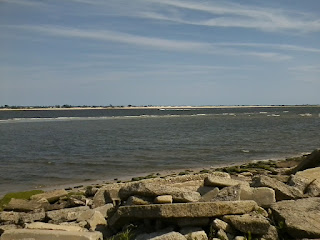I've just lost a friend.
You've seen him on these pages. He's one of the most loving and friendly beings I've ever known.
Sometimes he would climb on me while I was sleeping. I didn't mind: When I woke to him, I felt the sun rising. He looked like a sunrise.
I am talking about Max, the orange cat who's lived with me for ten and a half years.
He came into my life on 9 April 2007. My friend Millie rescued him from a street near us. She told me that when she saw him, she walked right up to him. He did the same for me the first time I saw him.
What that meant, of course, was that he is anything but a feral cat. "He must have had a home before," Millie observed. When I saw him, I couldn't not give him one.
The vet said he was between five and seven years old when I brought him home. So, that means he lived about sixteen or seventeen years--a pretty good lifespan for a cat.
Even if he'd been in my life for only a day, he could have given me a lifetime of happiness: That is what he carried with him, and couldn't help but to give. He greeted everyone who came to my apartment--including Marlee, the day I brought her home--like an old friend and playmate.
He died late Sunday night, after I'd come back from a nice ride, had a sumptuous dinner and talked to my mother. I wrote yesterday's post about the ride I took Sunday, the day before, because it was just too difficult to talk about Max.
He won't be waiting for me at the end of my next ride. Not physically, anyway. I believe, though, that I'll see him at the end of many rides for a long time to come.
Note: In a sad irony, I lost another cat--the first one I had who was named Charlie--on 16 October in 2005.
You've seen him on these pages. He's one of the most loving and friendly beings I've ever known.
Sometimes he would climb on me while I was sleeping. I didn't mind: When I woke to him, I felt the sun rising. He looked like a sunrise.
I am talking about Max, the orange cat who's lived with me for ten and a half years.
He came into my life on 9 April 2007. My friend Millie rescued him from a street near us. She told me that when she saw him, she walked right up to him. He did the same for me the first time I saw him.
What that meant, of course, was that he is anything but a feral cat. "He must have had a home before," Millie observed. When I saw him, I couldn't not give him one.
The vet said he was between five and seven years old when I brought him home. So, that means he lived about sixteen or seventeen years--a pretty good lifespan for a cat.
Even if he'd been in my life for only a day, he could have given me a lifetime of happiness: That is what he carried with him, and couldn't help but to give. He greeted everyone who came to my apartment--including Marlee, the day I brought her home--like an old friend and playmate.
He died late Sunday night, after I'd come back from a nice ride, had a sumptuous dinner and talked to my mother. I wrote yesterday's post about the ride I took Sunday, the day before, because it was just too difficult to talk about Max.
He won't be waiting for me at the end of my next ride. Not physically, anyway. I believe, though, that I'll see him at the end of many rides for a long time to come.
Note: In a sad irony, I lost another cat--the first one I had who was named Charlie--on 16 October in 2005.























